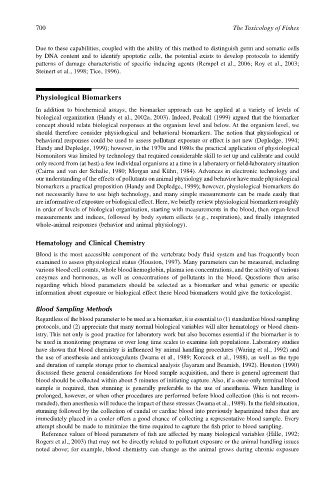Page 720 - The Toxicology of Fishes
P. 720
700 The Toxicology of Fishes
Due to these capabilities, coupled with the ability of this method to distinguish germ and somatic cells
by DNA content and to identify apoptotic cells, the potential exists to develop protocols to identify
patterns of damage characteristic of specific inducing agents (Rempel et al., 2006; Roy et al., 2003;
Steinert et al., 1998; Tice, 1996).
Physiological Biomarkers
In addition to biochemical assays, the biomarker approach can be applied at a variety of levels of
biological organization (Handy et al., 2002a, 2003). Indeed, Peakall (1999) argued that the biomarker
concept should relate biological responses at the organism level and below. At the organism level, we
should therefore consider physiological and behavioral biomarkers. The notion that physiological or
behavioral responses could be used to assess pollutant exposure or effect is not new (Depledge, 1994;
Handy and Depledge, 1999); however, in the 1970s and 1980s the practical application of physiological
biomonitors was limited by technology that required considerable skill to set up and calibrate and could
only record from (at best) a few individual organisms at a time in a laboratory or field-laboratory situation
(Cairns and van der Schalie, 1980; Morgan and Kühn, 1984). Advances in electronic technology and
our understanding of the effects of pollutants on animal physiology and behavior have made physiological
biomarkers a practical proposition (Handy and Depledge, 1999); however, physiological biomarkers do
not necessarily have to use high technology, and many simple measurements can be made easily that
are informative of exposure or biological effect. Here, we briefly review physiological biomarkers roughly
in order of levels of biological organization, starting with measurements in the blood, then organ-level
measurements and indices, followed by body system effects (e.g., respiration), and finally integrated
whole-animal responses (behavior and animal physiology).
Hematology and Clinical Chemistry
Blood is the most accessible component of the vertebrate body fluid system and has frequently been
examined to assess physiological status (Houston, 1997). Many parameters can be measured, including
various blood cell counts, whole blood hemoglobin, plasma ion concentrations, and the activity of various
enzymes and hormones, as well as concentrations of pollutants in the blood. Questions then arise
regarding which blood parameters should be selected as a biomarker and what generic or specific
information about exposure or biological effect these blood biomarkers would give the toxicologist.
Blood Sampling Methods
Regardless of the blood parameter to be used as a biomarker, it is essential to (1) standardize blood sampling
protocols, and (2) appreciate that many normal biological variables will alter hematology or blood chem-
istry. This not only is good practice for laboratory work but also becomes essential if the biomarker is to
be used in monitoring programs or over long time scales to examine fish populations. Laboratory studies
have shown that blood chemistry is influenced by animal handling procedures (Waring et al., 1992) and
the use of anesthesia and anticoagulants (Iwama et al., 1989; Korcock et al., 1988), as well as the type
and duration of sample storage prior to chemical analysis (Jayaram and Beamish, 1992). Houston (1990)
discussed these general considerations for blood sample acquisition, and there is general agreement that
blood should be collected within about 5 minutes of initiating capture. Also, if a once-only terminal blood
sample is required, then stunning is generally preferable to the use of anesthesia. When handling is
prolonged, however, or when other procedures are performed before blood collection (this is not recom-
mended), then anesthesia will reduce the impact of these stresses (Iwama et al., 1989). In the field situation,
stunning followed by the collection of caudal or cardiac blood into previously heparinized tubes that are
immediately placed in a cooler offers a good chance of collecting a representative blood sample. Every
attempt should be made to minimize the time required to capture the fish prior to blood sampling.
Reference values of blood parameters of fish are affected by many biological variables (Hille, 1992;
Rogers et al., 2003) that may not be directly related to pollutant exposure or the animal handling issues
noted above; for example, blood chemistry can change as the animal grows during chronic exposure

